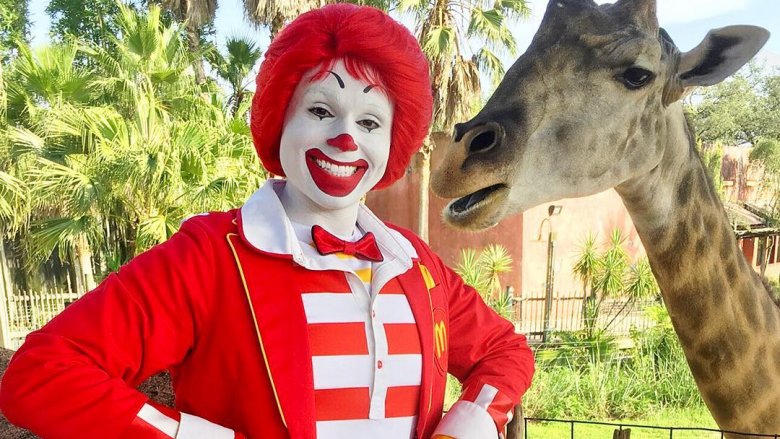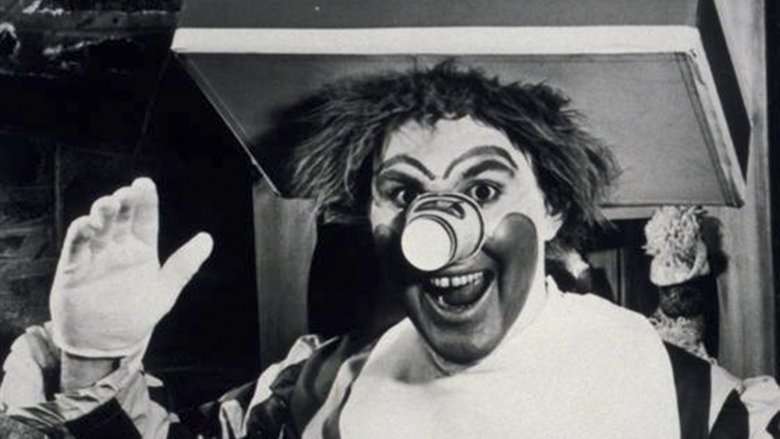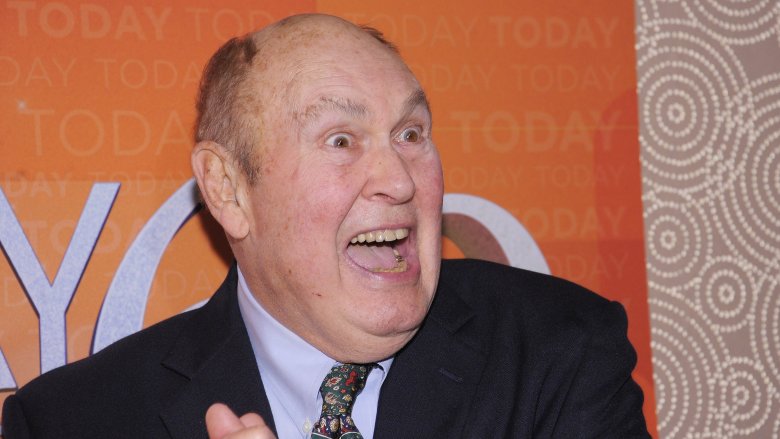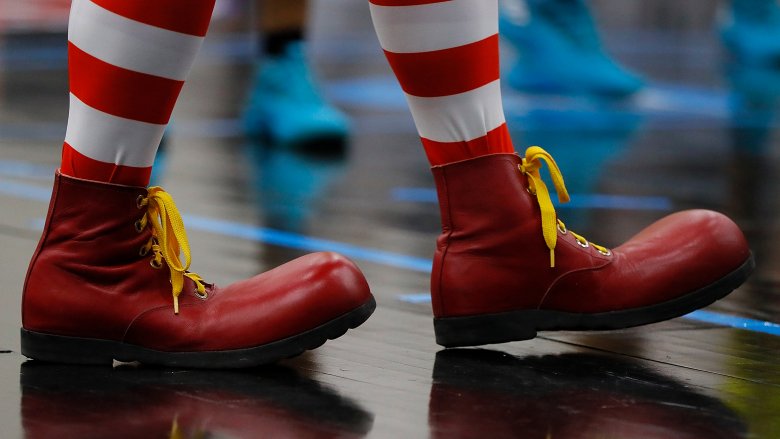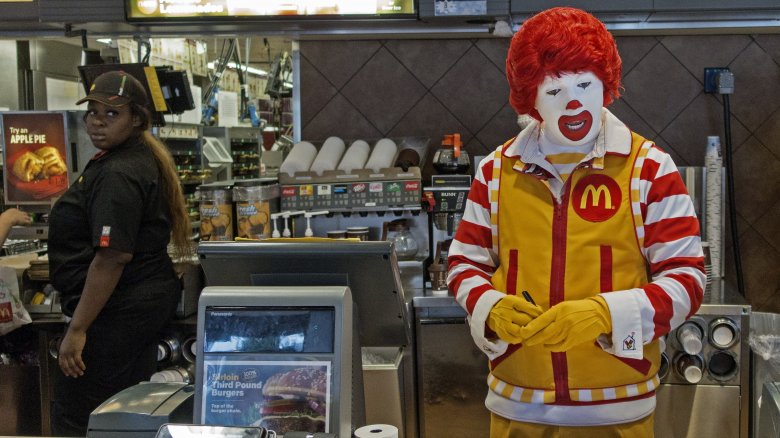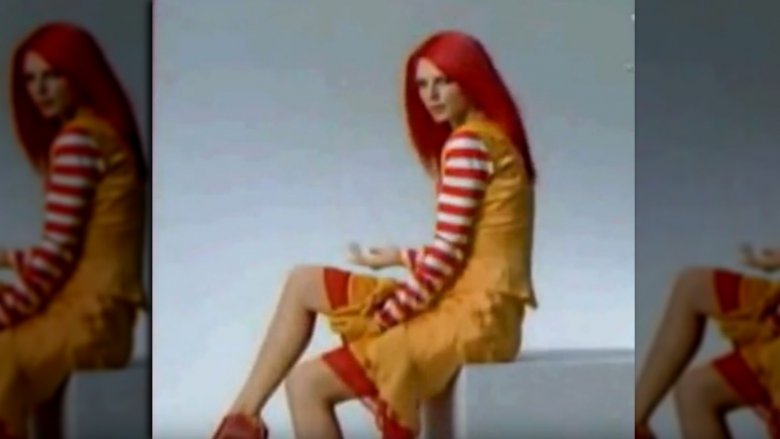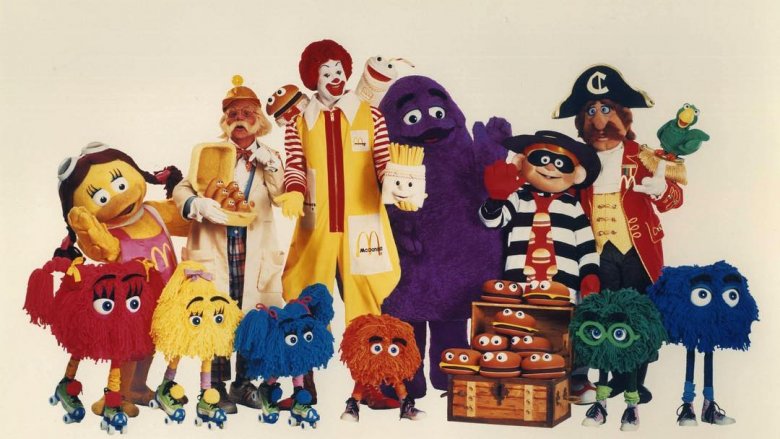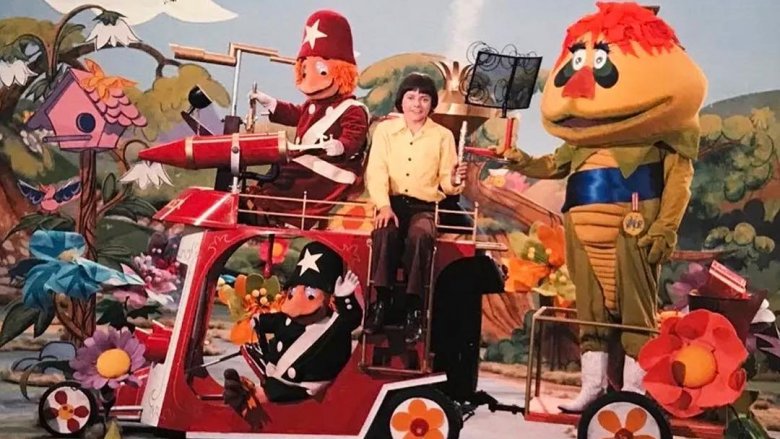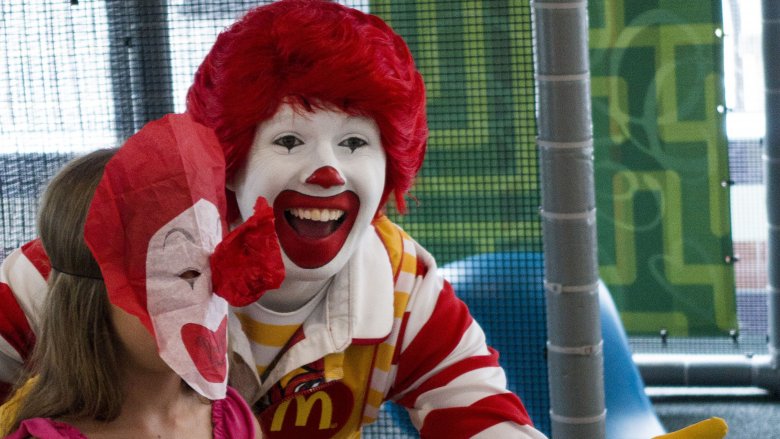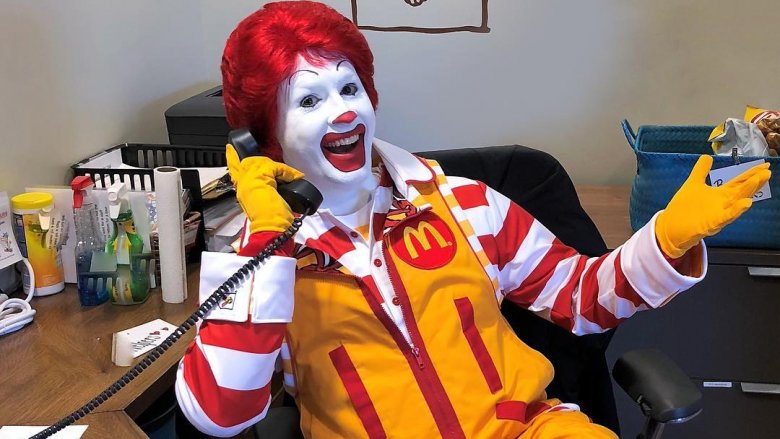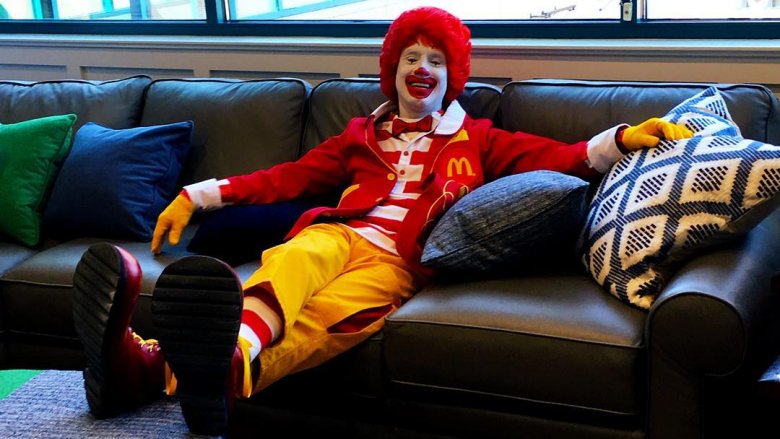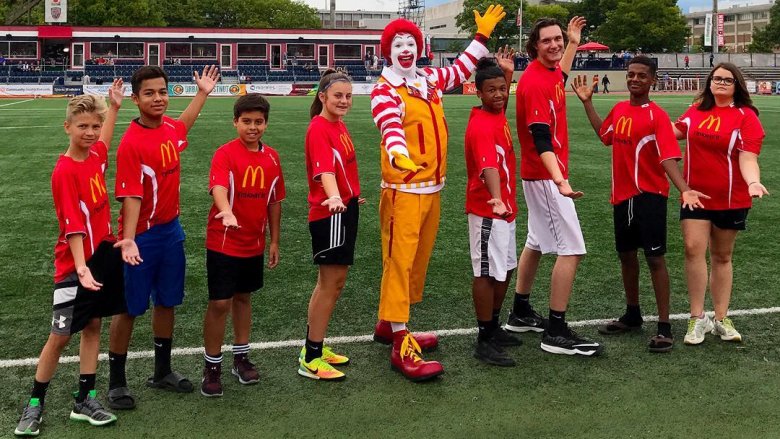The Untold Truth Of Ronald McDonald
Whether you find him charming or creepy, — or an odd combination of both — there is no doubt that you have been thoroughly exposed to the real king of burgers — Ronald McDonald. The red-haired clown from McDonald's made his first appearance in the 60s, making children and adults alike hunger for cheap, fast food cheeseburgers that were presented like little gift-wrapped presents. With Ronald's help, McDonald's became a behemoth, and the famed clown's likeness spawned an endless line of restaurants, television commercials, merchandise, video games, movies, and of course, the children's charity, The Ronald McDonald House.
The world-famous clown has enjoyed his ups and downs over the years, from being one of the most recognizable faces in America, to enduring a health-conscious backlash, and a complete overhaul of his image and branding. Though we have all grown up with Ronald over the years, there's probably a lot you never knew about the man with the big red shoes.
Ronald McDonald's original look was pretty creepy
You probably wouldn't recognize the original version of Ronald McDonald. The first version of the hamburger-loving clown was created by famed weatherman, Willard Scott — or so he says in his book, The Joy of Living. Scott was appearing as television's Bozo the Clown, when he was asked to step in and help market a local location of the hamburger chain. When Bozo left the air, Scott claims that McDonald's asked him to create a new character for the chain... and Ronald McDonald was born. (The owner of the first franchise where Scott performed, Oscar Goldstein, is often named as the creator of the character.)
Scott's version of Ronald McDonald was nothing like the red-haired clown we know today. The original Ronald was a freaky combination of clown and fast food dispenser, who sported a paper soda cup for a nose, a serving tray that balanced a complete meal for a hat, and a magical belt that served up a mysteriously never-ending supply of McDonald's hamburgers. The creepiness continued for three television commercials which include Scott's Ronald McDonald talking a young boy into hanging out with him and accepting food, even though the kid's mom told him not to talk to strangers, and Ronald hitching a ride to the moon by clutching the side of a rocket ship.
Fat Ronald McDonald got the boot
Ronald McDonald was a hit for the company, and once the possibilities of the character being a cowboy or spaceman were scrapped, plans were soon underway to market the clown to the entire country. But before that would happen, McDonald's would replace Scott with a redesigned clown, played by famed Ringling Brothers circus performer, Michael "Coco" Polakovs, who is credited as coming up with the basic look of the white-faced, red-haired, yellow-jumpsuit-wearing Ronald that is pretty close to the clown we are all familiar with today.
What was the reason that Scott was given his pink slip? Ironically, the top brass at McDonald's thought a less portly performer, like the tall and slender Coco the Clown, would better embody the clown employed to sling french fries and milkshakes to kids. As plans moved forward to use the character in advertisements that would span the nation, the company worried that finding performers of Scott's ample proportions in each market to appear in its franchise locations may prove more difficult. Scott told the Wall Street Journal, "That was a heartbreaker. I was too fat." Lucky for Scott, there were no such requirements over at NBC, where he served as the weatherman on the Today Show for 35 years.
It's not easy being Ronald McDonald
Actors who have played the role of Ronald McDonald, (and somehow gotten out of non-disclosure agreements,) tell a tale of a strict set of rules to keep the character up to corporate standards. Fact Fiend reports that actor Geoffrey Giuliano, who donned the red wig in the 70s, was particularly troubled at having to tell children that the burgers came from a magic hamburger patch, instead of from cows. Another Ronald performer narrowly avoided spending a night in a Saginaw, Michigan jail after a fender bender had him facing the local police. His crime? Not disclosing his civilian name, which according to corporate is a strict no-no for Ronald's when in costume. The cops ended up letting him go, unhappily depriving the rest of us of the best mug shots ever.
Back in 2003, McDonald's reportedly employed 250 Ronalds world-wide, with some enjoying the services of chauffeurs, assistants, and maybe even bodyguards, to fend off rock-throwing youngsters or protesters.
It was famed comedian and magician, Aye Jaye, who helped develop the handbooks, Ronald & How, and The Golden Rules of Schmoozing, that would guide all Top of Minds (TOMS), as the company refers to their cadre of working Ronalds. Dubbed the "Boss Clown," Aye Jaye set ground rules for Ronalds that included instructions for makeup application, and handling children who were looking for a hug — Ronalds were instructed to give them a simple pat on the back instead.
One Ronald McDonald to rule them all
McDonald's headquarters is notoriously tight-lipped about the details of what goes into hiring and training the actors who play Ronald McDonald. And the reason for that is because according to McDonald's, there are no actors playing the part. The official stance of the company is that Ronald McDonald is just one, real clown.
Long-time CEO, James Skinner, once famously exclaimed in a meeting that "Ronald hasn't been here because he's out in the field busy doing work and fighting through the protesters," perpetuating the idea that the character was just one, real person. When pressed for an answer as to how Ronald was able to appear at so many events around the world in the course of one day, McDonald's released a statement, from Ronald of course, saying "If I told you all my secrets, they wouldn't be secrets anymore. Let's just say that between you, me and Santa, it's magic."
According to the Wall Street Journal, the company is able to preserve the illusion of Ronald being one person by making sure that no two Ronalds are ever photographed or appear in public together. In fact, the only place they might have been spotted together would be at the company's convention in Oak Brook, Illinois. The convention wasn't all fun and games for the group of clowns, who risked probation or even dismissal if they didn't pass the convention's strict, Ronald inspections.
Ronald McDonald got a big makeover in Japan
While the Ronald McDonald character has been standardized to corporate specifications, there are some countries where the Ronald McDonald we all know and love may have a very different image.
In Japan, Ronald McDonald is simply called "Donald McDonald," a translation that wasn't quite the tongue twister that his full name would be in Japanese, and was natural to Japanese tongues that were already familiar with Donald Duck. One Japanese ad campaign has even reimagined the character to include sexier, younger versions of the clown, sans makeup, that appear to be hip, gender-bending versions of Donald, or perhaps meant to be his son and daughter. The advertisements for the Tomato McGrand sandwich feature stylish twenty-somethings in high-fashion versions of Ronald's classic attire, with a young, female version of Donald donning a red and white striped tankini.
The man behind the campaign, known as "Kazoo," insists he wasn't trying to make a female Ronald McDonald, but rather giving a nod to Japan's popular culture trend of "cospre" costume play. Kazoo says that the campaign was such a hit, that it was "rated number one likeable among high school girls."
McDonaldland is no more
If you were growing up from the 70s to early 00s, no doubt the Ronald McDonald that you know and love is associated with the wacky gang of critters he pals around with in McDonaldland. In national television advertisements, children were introduced to a magical world inhabited by Ronald's friends like Mayor McCheese, Officer Big Mac, and the Professor, fighting the likes of the sandwich-stealing Captain Crook and the Hamburglar. Grimace, Ronald's portly purple pal, started off as a shake-stealing, four-armed villain, but was eventually promoted to Ronald's bumbling buddy. Over the years, some characters were phased out, but newer characters were introduced, like breakfast-loving Birdie the Early Bird, the McNugget Buddies, Shamrock Shake-fan Uncle O'Grimacy, and alien surfer-dude CosMC.
McDonaldland, sadly, closed its magical doors in 2003, when McDonald's switched gears to the "I'm Lovin' It" campaign that you can still hear jingling in your ears today. If you are feeling nostalgic, you may be able to visit an aging McDonald's Playplace, outfitted with a Fry Guys carousel, or an Officer Big Mac jail. Plans to reintroduce one of McDonaldland's iconic characters, the Hamburglar, in 2015, were met with mixed reviews, and we haven't seen any more advertisements featuring the live-action, male model who donned the burger thief's costume.
McDonaldland got McSued
Linking McDonaldland toys to kid-targeted Happy Meals in the late 70s pushed the world of McDonaldland-mania into another stratosphere. Ronald and the gang appeared on drinking glasses, board games, school supplies, action figures, clothing, and all manner of household items. The McDonaldland Fun Times Magazine was published six times per year, and featured puzzles, jokes, and crafts. Home video games like McDonald's Treasure Land Adventure and M.C. Kids were made for Sega and Nintendo Entertainment Systems. Ronald appeared on the big screen in 1988's feature film, Mac and Me.
But McDonaldland taking the world by storm came very close to not happening at all.
McDonaldland seemed destined for doom when it was deemed that McDonald's had infringed on the ideas and likenesses of Sid and Marty Krofft's H.R. Pufnstuf. The similarities between the characters and the worlds were hard to miss, particularly Mayor McCheese's resemblance to H.R. Pufnstuf himself, complete with enormous head and mayoral sash. McDonald's advertising executives did not deny that they had indeed consulted with producers Sid and Marty Krofft to create McDonaldland, but claimed to have canceled the project. Rubbing more salt in the wound, McDonald's went on to hire former employees of the Kroffts, as well as their star voiceover actor.
A couple of court cases that spanned nearly 14 years, and a sizeable payout to the Kroffts later, McDonald's carried on with the branding of Ronald's psychedelic, hamburger-filled universe.
Ronald McDonald was bigger than Jesus
At the height of Ronald McDonald's popularity, when a kid might want to proudly sport a lunchbox at school emblazoned with his likeness, Ronald McDonald was said to be so huge, he was more popular than Jesus. Marketing Week made this declaration in a 1995 headline, when a marketing survey of 7,000 people across eight countries found that far more people recognized the corporate symbol of McDonald's than they did the Christian cross. Morgan Spurlock proved this point to be true in his 2004 documentary, Super Size Me, in a clip where school kids all recognize who Ronald is, but mistake an image of Jesus for George W. Bush.
Eric Schlosser's bestseller, Fast Food Nation: The Dark Side of the All American Meal, a 2001 expose and commentary on the state of the corporatization of the American diet, details McDonald's ascent to the most recognized brand in the world. Spending more money on marketing and advertising than any of its competitors, McDonald's launched Ronald McDonald into a superstar who could be identified by a whopping 96 percent of American, school-aged children. The only fictional character more recognizable, according to Schlosser, was another character who dresses in red and white — Santa Claus.
Ronald McDonald doesn't eat McDonald's food
In 2013, then-CEO Don Thompson denied that the company contributes to obesity, pointing out a very interesting tidbit about the company's famous mascot — Ronald McDonald himself is never actually seen eating the food from his own restaurant. He called Ronald just a clown who "represents our charity." The 2007 CEO, Jim Skinner, wildly claimed that "Ronald McDonald has never sold food to kids in the history of his existence." An outrageous statement considering the original Ronald doled out all-you-can-eat burgers from a magical belt, and the 70s Ronald in this commercial can clearly be seen tucking into a McDonald's cheeseburger. But the company has made a noticeable move to distance Ronald from the food he supposedly doesn't peddle over the years. Actor Geoffrey Giuliano, who appeared as Ronald in the late 70s, has stated he was never allowed to eat the food while in character, because it would appear "unseemly."
In 2014, McDonald's Becca Hary told The Huffington Post that when Ronald appears in public "he is focused on spreading joy and smiles." And in a final response to the demands for Ronald's retirement? McDonald's latest CEO, Steve Easterbrook, declared in the 2015 shareholders meeting that Ronald didn't need to worry about filing for unemployment. "With regards to Ronald, Ronald's here to stay," he said.
People hated hipster Ronald McDonald
In 2014, McDonald's announced that the red-haired clown would be receiving a makeover. The Tony-winning costume designer of Broadway's Beauty and the Beast updated Ronald's classic look with a hipster-ish red blazer and bowtie. His less-formal, sporty ensemble includes a yellow windbreaker with the classic candy-cane-striped sleeves. The big red shoes? Those remain the same.
Another big claim made by the company in 2014, promoting the newer, hipper Ronald? Apparently, the plan was to bolster Ronald's social media presence, with the company quoting Ronald as proclaiming, "Selfies, here I come!", and a promise to tweet on Ronald's behalf using the hashtag, #ronaldmcdonald. Sadly, the company didn't break the internet quite the way they may have originally intended, perhaps because so many people took to Twitter with decidedly mixed reviews about his makeover. Said one user, "A creepy clown in a cheap dinner jacket is still a creepy clown."
While he may not have his own presence on Twitter and Facebook, Ronald does have his very own Instagram account, highlighting his charitable and fitness-focused activities around the globe.
Backlash may have sent Ronald McDonald packing
McDonald's is certainly no stranger to backlash over the nutrition values, or lack thereof, in the food that it sells.
Ronald McDoanld's star had already begun to tarnish a bit by 2010, when a Corporate Accountability International poll found that almost half of all Americans felt it was time for the burger-lovin' clown to hang up his red shoes for good. The reason? "This clown is no friend to our children or their health," said Deborah Lapidus, a spokesperson for the group, who called Ronald a "deep-fried Joe Camel for the 21st century." The company's website leads to a 32-page eBook called Clowning with Kids' Health, The Case for Ronald McDonald's Retirement, detailing how Ronald is complicit in the obesity epidemic.
More than 550 doctors apparently agreed with the poll, and penned a letter to McDonald's imploring the company to "stop marketing junk food to kids," and claiming that "Ronald captures kids' attention better than anyone else can." The letter appeared in full-page ads in newspapers across the US.
And it may have worked. While Ronald McDonald may still be the face of McDonald's charities, he no longer seems to be the face of McDonald's. He's not on their website, and hasn't appeared on their social media for years.
